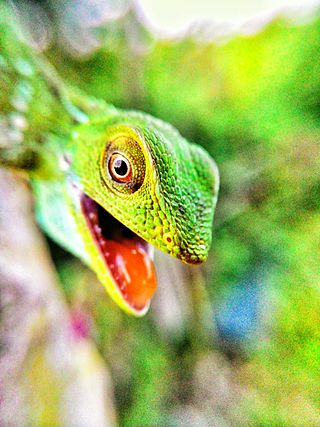
Dibamidae or blind skinks is a family of lizards characterized by their elongated cylindrical body and an apparent lack of limbs. Female dibamids are entirely limbless and the males retain small flap-like hind limbs, which they use to grip their partner during mating. They have a rigidly fused skull, lack pterygoid teeth and external ears. Their eyes are greatly reduced, and covered with a scale.

The Mexican blind lizard is a species of legless lizard in the family Dibamidae, and the only species in the genus Anelytropsis. It is endemic to Mexico. They look like Amphisbaenia, but are in fact, only distantly related.

Dibamus is a genus of legless lizards in the family Dibamidae.

Barkudia insularis, commonly known as the Madras spotted skink, is a critically endangered limbless skink which was described in 1917 by Nelson Annandale and rediscovered in the wild in 2003. Little is known about the species but it was previously believed to be found only in the mangrove habitats near Barkuda Island in Chilka Lake, Odisha, India. Later observations in adjoining parts of Odisha indicate a larger range within the state. The lizard looks like a large earthworm and lives in the subsoil and probably feeds on small arthropods.

Bronchocela cristatella, also known as the green crested lizard, is a species of agamid lizard endemic to Southeast Asia.

Bronchocela jubata, commonly known as the maned forest lizard, is a species of agamid lizard found mainly in Indonesia on the islands of Singkep, Java, Bali, Sulawesi, Karakelang, Salibabu; Nias Island, Singkap Island, Borneo (Kalimantan) also in Thailand, Cambodia and Philippines. Although in the past it was thought the species may be found in India, either on the mainland or in the Nicobars, this is not the case according to herpetologist Das. It is also known by the common name of "bloodsucker", although this is a misnomer.
Gongylosoma nicobariensis, the Camorta Island stripe-necked snake, is a species of snake found in the Nicobar Islands of India. Species known only from its holotype.

Ophisops jerdonii, commonly known as Jerdon's cabrita, Jerdon's snake-eye, or Punjab snake-eyed lacerta, is a species of lacertid lizard, which is distributed in east Afghanistan, Pakistan, and India.
Ophisops microlepis, the small-scaled lacerta, is a species of lizards found in parts of India.
The big-eared lipinia is a species of skink in the family Scincidae. It is endemic to the Andaman and Nicobar Islands of India.
The white-spotted supple skink is a species of diurnal, terrestrial, insectivorous skink found in parts of tropical Asia. This species was first described by John Edward Gray based on type specimen collected by T. C. Jerdon from Madras, in the Coromandel Coast of South India.

The bronze grass skink, bronze mabuya or speckled forest skink, is a species of skink found in South and Southeast Asia. It is a common, but shy, ground-dwelling species that is active both day and night.

Eutropis multifasciata, commonly known as the East Indian brown mabuya, many-lined sun skink, many-striped skink, common sun skink or (ambiguously) as golden skink, is a species of skink.

Eutropis rugifera, variously known as Nicobar Island skink or rough-scaled sun skink, is a species of skink from southeastern Asia.

Sphenomorphus indicus is a species of skink.
Dibamus dezwaani is a species of legless lizard in the family Dibamidae. The species is endemic to the island of Nias, off Sumatra (Indonesia).
Dibamus ingeri is a species of legless lizard in the family Dibamidae. The species is endemic to Borneo.
Dibamus tiomanensis, or the Tioman Island blind lizard, is a legless lizard endemic to Tioman Island in Malaysia. These lizards can reach 12.3 cm (4.8 in) in snout–vent length. A distinguishing characteristic of this species is that they are brown in color with a lighter brown/tan color on their snout and jaw.
Dibamus vorisi is a species of legless lizard in the family Dibamidae. The species is endemic to Borneo.
Flower's blind lizard is a legless lizard endemic to peninsular Malaysia. It is between 8–13 cm (3.1–5.1 in) long and is gray-brown in color with a lighter ventral surface and a silver-gray band. It burrows beneath rocks, leaf-litter and rotting logs.









